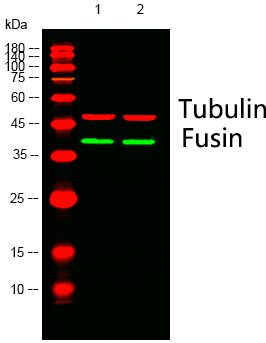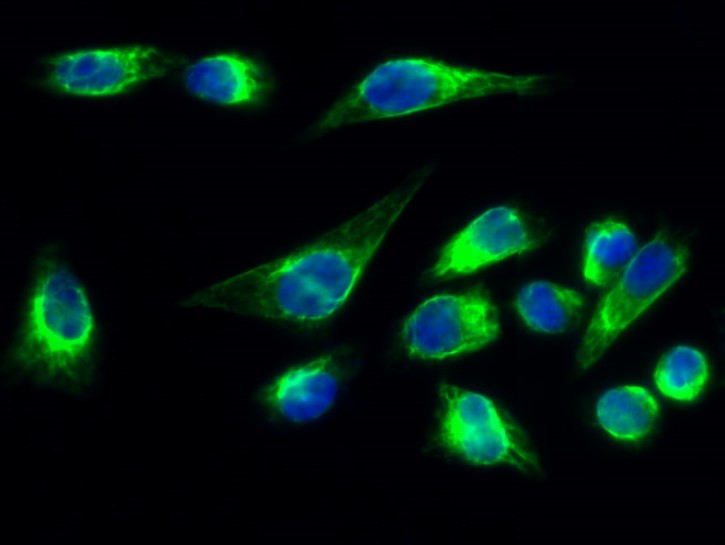Total CXCR4 Cell-Based Colorimetric ELISA Kit
- Catalog No.:KA4384C
- Applications:ELISA
- Reactivity:Human
- Gene Name:
- CXCR4
- Human Gene Id:
- 7852
- Human Swiss Prot No:
- P61073
- Mouse Swiss Prot No:
- P70658
- Storage Stability:
- 2-8°C/6 months
- Other Name:
- C-X-C chemokine receptor type 4 (CXC-R4) (CXCR-4) (FB22) (Fusin) (HM89) (LCR1) (Leukocyte-derived seven transmembrane domain receptor) (LESTR) (NPYRL) (Stromal cell-derived factor 1 receptor) (SDF-1 receptor) (CD antigen CD184)
- Detection Method:
- Colorimetric
- Background:
- alternative products:Additional isoforms seem to exist,caution:Was originally (PubMed:8329116 and PubMed:8234909) thought to be a receptor for neuropeptide Y type 3 (NPY3R) (NPY3-R).,disease:Defects in CXCR4 are a cause of WHIM syndrome [MIM:193670]; also called warts, hypogammaglobulinemia, infections, and myelokathexis. WHIM syndrome is an immunodeficiency disease characterized by neutropenia, hypogammaglobulinemia and extensive human papillomavirus (HPV) infection. Despite the peripheral neutropenia, bone marrow aspirates from affected individuals contain abundant mature myeloid cells, a condition termed myelokathexis.,domain:The amino-terminus is critical for ligand binding. Residues in all four extracellular regions contribute to HIV-1 coreceptor activity.,function:Receptor for the C-X-C chemokine CXCL12/SDF-1. Transduces a signal by increasing the intracellular calcium ions level. Involved in haematopoiesis and in cardiac ventricular septum formation. Plays also an essential role in vascularization of the gastrointestinal tract, probably by regulating vascular branching and/or remodeling processes in endothelial cells. Could be involved in cerebellar development. In the CNS, could mediate hippocampal-neuron survival. Acts as a coreceptor (CD4 being the primary receptor) for HIV-1 X4 isolates and as a primary receptor for some HIV-2 isolates. Promotes Env-mediated fusion of the virus.,online information:CXC chemokine receptors entry,online information:CXCR4 entry,online information:CXCR4 mutation db,PTM:O- and N-glycosylated. Asn-11 is the principal site of N-glycosylation. There appears to be very little or no glycosylation on Asn-176. N-glycosylation masks coreceptor function in both X4 and R5 laboratory-adapted and primary HIV-1 strains through inhibiting interaction with their Env glycoproteins. The O-glycosylation chondroitin sulfate attachment does not affect interaction with CXCL12/SDF-1alpha nor its coreceptor activity.,PTM:Sulfation on Tyr-21 is required for efficient binding of CXCL12/SDF-1alpha and promotes its dimerization.,similarity:Belongs to the G-protein coupled receptor 1 family.,subunit:Monomer. Can form dimers. Interacts with HIV-1 surface protein gp120 and Tat.,tissue specificity:Expressed in numerous tissues, such as peripheral blood leukocytes, spleen, thymus, spinal cord, heart, placenta, lung, liver, skeletal muscle, kidney, pancreas, cerebellum, cerebral cortex and medulla (in microglia as well as in astrocytes), brain microvascular, coronary artery and umbilical cord endothelial cells. Isoform 1 is predominant in all tissues tested.,
- Function:
- MAPKKK cascade, activation of MAPK activity, cell morphogenesis, cell morphogenesis involved in differentiation,angiogenesis, blood vessel development, patterning of blood vessels, response to hypoxia, ameboidal cell migration,morphogenesis of a branching structure, neuron migration, cell activation, vasculature development, reproductive developmental process, protein amino acid phosphorylation, phosphorus metabolic process, phosphate metabolic process, cellular ion homeostasis, cellular calcium ion homeostasis, cellular metal ion homeostasis, apoptosis, cell motion, chemotaxis, defense response, inflammatory response, immune response, cell surface receptor linked signal transduction, G-protein coupled receptor protein signaling pathway, elevation of cytosolic calcium ion concentration,intracellular signaling cascade, protein kinase cascade, gamete generation, germ cell development, patt
- Subcellular Location:
- Cell membrane ; Multi-pass membrane protein . Cell junction. Early endosome. Late endosome. Lysosome. In unstimulated cells, diffuse pattern on plasma membrane. On agonist stimulation, colocalizes with ITCH at the plasma membrane where it becomes ubiquitinated. In the presence of antigen, distributes to the immunological synapse forming at the T-cell-APC contact area, where it localizes at the peripheral and distal supramolecular activation cluster (SMAC).
- Expression:
- Expressed in numerous tissues, such as peripheral blood leukocytes, spleen, thymus, spinal cord, heart, placenta, lung, liver, skeletal muscle, kidney, pancreas, cerebellum, cerebral cortex and medulla (in microglia as well as in astrocytes), brain microvascular, coronary artery and umbilical cord endothelial cells. Isoform 1 is predominant in all tissues tested.
- June 19-2018
- WESTERN IMMUNOBLOTTING PROTOCOL
- June 19-2018
- IMMUNOHISTOCHEMISTRY-PARAFFIN PROTOCOL
- June 19-2018
- IMMUNOFLUORESCENCE PROTOCOL
- September 08-2020
- FLOW-CYTOMEYRT-PROTOCOL
- May 20-2022
- Cell-Based ELISA│解您多样本WB检测之困扰
- July 13-2018
- CELL-BASED-ELISA-PROTOCOL-FOR-ACETYL-PROTEIN
- July 13-2018
- CELL-BASED-ELISA-PROTOCOL-FOR-PHOSPHO-PROTEIN
- July 13-2018
- Antibody-FAQs


